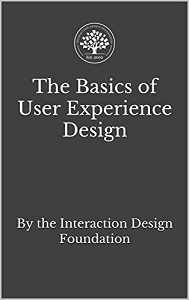
|
FreeComputerBooks.com
Links to Free Computer, Mathematics, Technical Books all over the World
|
|
-
 A Practical Guide to Designing for the Web (Mark Boulton)
A Practical Guide to Designing for the Web (Mark Boulton)
This book aims to teach you techniques for designing your website using the principles of graphic design. Featuring five sections, each covering a core aspect of graphic design: Getting Started, Research, Typography, Colour, and Layout.
-
 Designing for Performance: Weighing Aesthetics and Speed
Designing for Performance: Weighing Aesthetics and Speed
As a web designer, you encounter tough choices when it comes to weighing aesthetics and performance. This book helps you approach projects with page speed in mind, showing you how to test and benchmark which design choices are most critical.
-
 Adaptive Web Design: Crafting Rich Experiences
Adaptive Web Design: Crafting Rich Experiences
This book frames the web design process in the lens of progressive enhancement. You will learn how content strategy, UX, HTML, CSS, responsive web design, JavaScript, server-side programming, and performance optimization all come together.
-
 The Design Of Everyday Things (Don Norman)
The Design Of Everyday Things (Don Norman)
This book melds psychology, marketing, and design concepts to show why we're susceptible to certain persuasive techniques. Packed with examples from every nook and cranny of the web, it provides easily digestible and applicable patterns.
-
 Design: Creation of Artifacts in Society (Karl Ulrich)
Design: Creation of Artifacts in Society (Karl Ulrich)
This book provides a unifying framework for understanding how artifacts are created in society. The treatment includes both a discussion of elements of design process as well as topical issues.
-
 The Fable of the User-Centered Designer (David Travis)
The Fable of the User-Centered Designer (David Travis)
User-centred design is ostensibly simple, yet when it comes to great user experiences many people do it incorrectly. After reading this book, you'll understand the framework of user-centred design and know how to apply it to your own design project.
-
 Access by Design: A Guide to Usability for Web Designers
Access by Design: A Guide to Usability for Web Designers
This book demonstrates how to create sites in which any user, regardless of accessibility needs, can access every element, even if they have an outdated search engine, slow modem, small device, or other less-than-optimal conditions.
-
 Pixel Perfect Precision (Tony Dones)
Pixel Perfect Precision (Tony Dones)
This is a comprehensive handbook on digital design covering much of ustwo's collective knowledge and process. It covers a lot of core principles and topics that apply to digital design, its relevant tools and accessibility.
-
 Research-Based Web Design and Usability Guidelines
Research-Based Web Design and Usability Guidelines
This book have been widely used by government, private, and academic institutions to improve Web design. Topics in the book include: home page design, page and site navigation, graphics and images, effective Web content writing, and search.
-
 The Shape of Design (Frank Chimero)
The Shape of Design (Frank Chimero)
Instead of talking about typography, grids, or logos, this book focuses on storytelling, co-dependency, and craft. It tries to supplement the abundance of technical talk and how-to elsewhere by elevating why great work is done.
-
 Building Accessible Websites (Joe Clark)
Building Accessible Websites (Joe Clark)
Using a strategic approach to the issues in a journalistic style, this book will be a foundation for how people think about this issue going forward-the first book people would read on the topic, before delving into the minutiae of the moment.
-
 Working through Screens (Jacob Burghardt)
Working through Screens (Jacob Burghardt)
This book is a reference for product teams creating new or iteratively improved applications for thinking work. It helps definers and designers to explore innovative new directions for their products.
-
 Web Style Guide: Basic Design Principles for Creating Web Sites
Web Style Guide: Basic Design Principles for Creating Web Sites
The book begins the presentation of its helpful and forward-looking advice with a discussion of the overall process of defining the objectives and users of your Web site, as well as the goals you will use to measure your progress.
-
 The Web Design CD Bookshelf - 6 Bestselling
The Web Design CD Bookshelf - 6 Bestselling
This collection delivers more than 3,000 pages of easily searchable information in a convenient format accessible from any web browser. . Programmers get a complete web design reference library they can easily carry anywhere.
-
 The Elements of Typographic Style Applied to the Web
The Elements of Typographic Style Applied to the Web
The typographic rules in this book aren't specific to particular software. You can apply these rules in just about any modern page-layout program or word processor - it skipped implementation issues that are especially basic or especially complicated.
-
 Butterick's Practical Typography (Matthew Butterick)
Butterick's Practical Typography (Matthew Butterick)
The typographic rules in this book aren't specific to particular software. You can apply these rules in just about any modern page-layout program or word processor - it skipped implementation issues that are especially basic or especially complicated.
-
 The Elements of Typographic Style (Robert Bringhurst)
The Elements of Typographic Style (Robert Bringhurst)
The typographic rules in this book aren't specific to particular software. You can apply these rules in just about any modern page-layout program or word processor - it skipped implementation issues that are especially basic or especially complicated.
-
 From ASCII Art to Comic Sans: Typography in the Digital Age
From ASCII Art to Comic Sans: Typography in the Digital Age
Offers an original vision of the history of typography and computing in the digital age, viewed through the lens of offbeat typography - shows how text is always an image that conveys meaning, and how typography has shaped modern visual and material culture.
-
 HTML5 for Web Designers (Jeremy Keith)
HTML5 for Web Designers (Jeremy Keith)
HTML5 isn't as confusing as it once was, but it still isn't straightforward. In this brilliant and entertaining user's guide, the author cuts to the chase, with crisp, clear, practical examples, and his patented twinkle and charm. You'll be up to speed in no time.
-
 The Basics of User Experience (UX) Design (Mads Soegaard)
The Basics of User Experience (UX) Design (Mads Soegaard)
If you're looking to gain an introduction into the world of user experience (UX) design - or maybe even freshen up your knowledge of the field - then this UX design book is the ideal place to start.
-
 The Psychology of Menu Selection (Kent L. Norman)
The Psychology of Menu Selection (Kent L. Norman)
Menu selection is emerging as an important mode of human/computer interaction. This book, devoted to the topic, provides detailed theoretical and empirical information of interest to software designers and human/computer interaction specialists, etc.
-
 Evil by Design: Design Patterns that Lead Us into Temptation
Evil by Design: Design Patterns that Lead Us into Temptation
This book melds psychology, marketing, and design concepts to show why we're susceptible to certain persuasive techniques. Packed with examples from every nook and cranny of the web, it provides easily digestible and applicable patterns.
-
 Search User Interfaces (Marti A. Hearst)
Search User Interfaces (Marti A. Hearst)
This book focuses on the human users of search engines and the tool they use to interact with them: the search user interface. The truly worldwide reach of the Web has brought with it a new realization among computer scientists and laypeople of the enormous importance of usability and user interface design.
-
 Building Web Apps for Everyone (Adam D. Scott)
Building Web Apps for Everyone (Adam D. Scott)
This book provides several options and best practices for using progressive enhancement, accessibility design, and inclusive web forms in your application. These features will help your online product fulfill Tim Berners-Lee's promise of a global communication network that enables everyone with a connection to participate fully.
-
 An Introduction to Adobe Photoshop (Steve Bark)
An Introduction to Adobe Photoshop (Steve Bark)
Learning Photoshop can be a daunting experience. This book is designed to place your feet firmly on the path to understanding and will guide you to the knowledge that will enable you to progress into a fast and productive Photoshop user.
-
 Web Developer's Library Bookshelf: 5 Bestselling Books
Web Developer's Library Bookshelf: 5 Bestselling Books
This is a comprehensive resource for Web programmers. The library features the electronic text of five popular O'Reilly titles. You'll find the latest editions of books, from HTML to JavaScript, etc.






